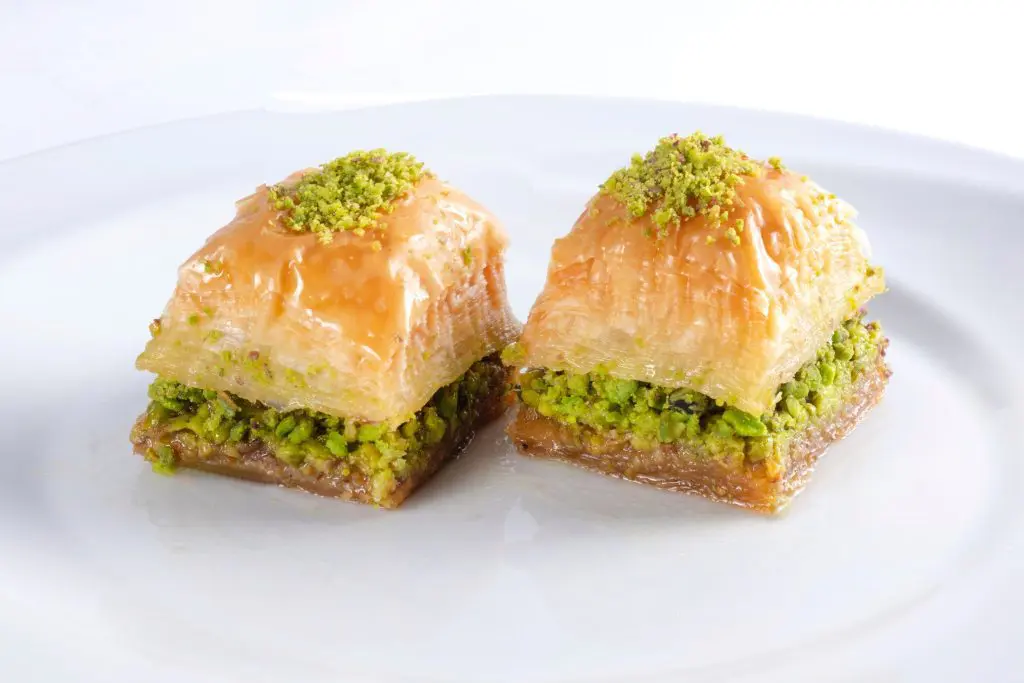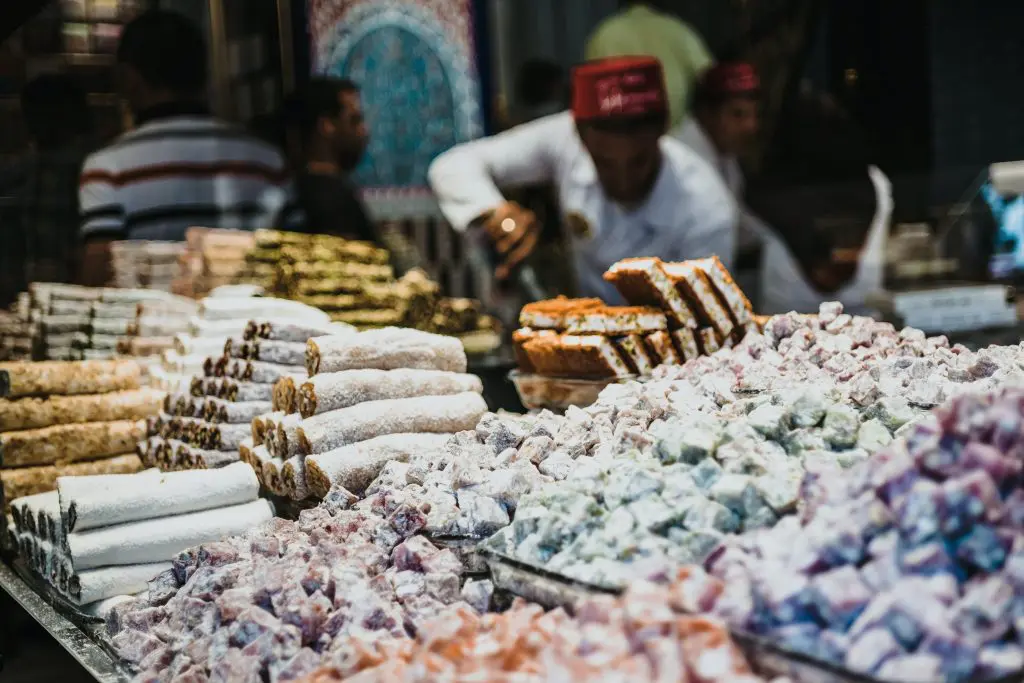
We’ve compiled essential suggestions to enhance your travel experience during your visit to Turkey. Read our guide and ensure enjoyment and the opportunity to savor renowned Top foods to eat in Turkey.
Warning: Embarking on a culinary journey through Turkey while harboring dietary aspirations may prove to be a futile endeavor! If you’re resolute in your quest to cut carbs or sculpt a beach-ready physique, Turkey might not be the most accommodating destination. The tantalizing aromas and flavors of Turkish cuisine have an almost magnetic pull, making it a daunting task to resist the abundance of culinary delights. Rooted in the rich legacy of Ottoman cuisine, which seamlessly incorporates diverse influences from Central Asia, the Balkans, and the Caucasus, Turkish gastronomy is a captivating fusion of tradition and innovation.
Recommended:
Subtitle for This Block
Title for This Block
Text for This Block

Written by Ashlee Delahunty
Travel Talk Contributor
As you traverse the culinary landscape of Turkey, the Top 11 foods to eat in this gastronomic haven are bound to capture your taste buds and leave a lasting impression. Beyond the iconic mountains of Turkish delight and the sizzle of juicy kebabs, a diverse array of delicacies awaits your exploration. Indulge in the aromatic richness of dishes like karnabahar tarator, a delightful cauliflower mezze, or relish the layers of flavor in manti, Turkish dumplings adorned with yogurt and garlic.
From the bustling markets of Istanbul to the quaint coastal towns, each region boasts its own culinary specialties. Dive into the earthy delights of testi kebab in Cappadocia or savor the fresh seafood along the Aegean coast. Turkish breakfast spreads, known as kahvaltı, offer a delightful array of cheeses, olives, and pastries to kickstart your day. The vibrant street food scene, featuring simit (Turkish sesame bread) and midye dolma (stuffed mussels), adds an extra layer of excitement to your culinary exploration.
So, if you find yourself in Turkey, heed the warning – surrendering to the temptation of Turkish cuisine is almost inevitable. With the Top 11 foods to eat in Turkey awaiting your palate, prepare for a gastronomic adventure that transcends borders and embraces the cultural diversity that defines this captivating country. Bon appétit!
Here are the top 11 foods to eat in Turkey…
1. Mantı (Turkish Ravioli)

It takes time to make these heavenly little lamb/beef stuffed dumplings though the speed at which most Turkish women can make them is impressive! Covered in a yoghurt and spice-laden sauce, this dish is completely unique and delicious.
What Is Turkish Mantı Made of?
Turkish Mantı is a traditional Turkish dish that consists of small, handmade dumplings filled with seasoned minced meat, usually lamb or beef. The dumplings are typically served with yogurt and topped with a tomato and garlic-infused butter sauce. Here’s a breakdown of the main components:
Dough: The dumpling dough is made from flour, water, and sometimes eggs. It is rolled out thinly and then cut into small squares.
Filling: The filling usually includes minced meat, such as lamb or beef, mixed with finely chopped onions and various spices. Common seasonings include salt, pepper, and sometimes a hint of garlic.
Yogurt Sauce: The dish is often accompanied by a sauce made with yogurt. The yogurt is typically thinned with water and sometimes flavored with minced garlic. It provides a creamy and tangy contrast to the savory dumplings.
Butter and Tomato Sauce: The finishing touch is a flavorful sauce made with butter and tomato. The butter is melted and mixed with tomato paste or tomato sauce. Garlic is often added for extra flavor.
The small dumplings are typically assembled by placing a small amount of the meat filling in the center of each dough square and then folding and pinching the edges to create a sealed pouch. The dumplings are then boiled until they are cooked through, and the yogurt and butter-tomato sauce are drizzled over the top before serving. This dish is often garnished with dried mint or red pepper flakes.
2. Meze

Turkish Delight, known as “Lokum” in Turkish, is a traditional sweet confectionery that has been enjoyed for centuries. It comes in a variety of flavors and can include different ingredients.
Some popular varieties of Turkish Delight include:
Rose (Gül): Rose-flavored Turkish Delight is one of the most traditional and classic varieties. It is often made with rosewater and has a distinct floral aroma.
Lemon (Limon): Lemon-flavored Turkish Delight has a citrusy and refreshing taste. It is commonly made with lemon juice or lemon extract.
Orange (Portakal): Orange-flavored Turkish Delight has a sweet and tangy flavor, often achieved with orange juice or orange extract.
Pomegranate (Nar): Pomegranate-flavored Turkish Delight features the sweet and slightly tart taste of pomegranate. It may contain pomegranate juice or extract.
Mint (Nane): Mint-flavored Turkish Delight has a refreshing and cooling taste, usually made with mint extract or fresh mint leaves.
Mastic (Sakız): Mastic-flavored Turkish Delight incorporates mastic resin, providing a unique and aromatic taste. Mastic is derived from the sap of the mastic tree.
Double Roasted (Çifte Kavrulmuş): This variety involves roasting the flour used in the confectionery twice, giving it a distinct flavor and texture.
Hazelnut (Fındık): Turkish Delight with hazelnuts combines the chewy sweetness of lokum with the crunchy texture and nutty flavor of hazelnuts.
Walnut (Ceviz): Walnut-filled Turkish Delight includes pieces of walnuts, adding a rich and earthy flavor to the confectionery.
Coconut (Hindistancevizi): Coconut-flavored Turkish Delight may include shredded coconut or coconut flavoring for a tropical twist.
Almond (Badem): Almond-filled Turkish Delight features almonds, offering a nutty flavor and crunchy texture.
Lavender (Lavanta): Lavender-flavored Turkish Delight incorporates the distinctive floral notes of lavender.
3. Kumpir

Turkish Kumpir is a popular street food that consists of a baked or roasted potato that is mashed and mixed with various toppings. The name “Kumpir” itself is derived from the Turkish word for “baked potato.” It is a customizable dish, and the choice of toppings can vary, but here are some common ingredients used in making Turkish Kumpir:
What Is Turkish Kumpir Made of?
Baked or Roasted Potato: The base of the dish is a large baked or roasted potato. The potato is usually cooked until the skin is crispy, and the inside is soft and fluffy.
Butter: Butter is often added to the mashed potato to enhance its richness and flavor.
Cheese: Grated or melted cheese is a common addition to Kumpir. It can be a variety of cheese, such as feta, cheddar, or mozzarella.
Sausages or Hot Dogs: Sliced sausages or hot dogs are sometimes used as a protein topping.
Olives: Sliced or chopped olives may be added for a salty and briny flavor.
Pickles: Pickles, either chopped or sliced, can provide a tangy and crunchy element.
Corn: Sweetcorn is a popular topping, adding a hint of sweetness and a pleasant crunch.
Peas and Carrots: Sometimes, cooked peas and carrots are included for additional color, texture, and flavor.
Mayonnaise and Ketchup: These condiments are often drizzled on top for added creaminess and tang.
Green and Red Peppers: Chopped or sliced peppers, either mild or hot, can be used for a spicy kick.
Tomatoes: Fresh diced tomatoes or tomato salsa can add freshness and acidity to the dish.
Customers typically have the option to choose their preferred toppings, creating a personalized Kumpir. It’s a popular street food in Turkey, especially in places like Ortaköy in Istanbul, where vendors offer a wide range of ingredients for customization.
4. Menemen

Like messy scrambled eggs or a take on shakshuka, mememen is a breakfast dish of spicy eggs cooked with oil, tomato, peppers and spices. It’s usually served in the metal dish it’s cooked in and eaten with chunks of bread (of course). Although you’ll find Turkey has many contrasts of food due to the sheer size of the country, you’ll be surprised to find that menemen is a fairly standard breakfast across the whole country.
What Is Turkish Menemen Made of?
Tomatoes: Menemen starts with ripe tomatoes, which are usually chopped or grated. Fresh, juicy tomatoes are essential for the flavorful base of the dish.
Green Peppers: Mild green peppers, such as bell peppers or similar varieties, are commonly used. They are diced and sautéed along with the tomatoes.
Eggs: Eggs are a central ingredient in Menemen. They are cracked directly into the pan and then mixed with the tomato and pepper mixture.
Olive Oil: Menemen is typically cooked in olive oil, which adds richness and flavor to the dish.
Onions (optional): Some recipes may include finely chopped onions for additional flavor, but this is optional.
Spices: Common spices used in Menemen include salt, black pepper, and red pepper flakes or paprika. These spices contribute to the dish’s savory and slightly spicy flavor.
Here’s a basic overview of how Menemen is prepared:
- Heat olive oil in a pan.
- Sauté chopped tomatoes and green peppers until they soften.
- Optionally, add finely chopped onions and continue cooking until translucent.
- Crack the eggs directly into the pan over the tomato and pepper mixture.
- Gently stir the eggs, allowing them to cook and form soft curds.
- Season the mixture with salt, black pepper, and red pepper flakes or paprika to taste.
- Continue cooking until the eggs are done to your liking.
- Menemen is often served hot, straight from the pan, and is commonly enjoyed with crusty bread on the side. It’s a simple yet flavorful dish that showcases the freshness of the ingredients.
5. Lahmacun

Turkish Lahmacun, often referred to as Turkish pizza, is a popular street food in Turkey. It consists of a thin, unleavened flatbread topped with a mixture of minced meat and flavorful spices. Here are the main components of Turkish Lahmacun:
What Is Turkish Lahmacun Made of?
Dough: The flatbread used for Lahmacun is typically made from a simple dough consisting of flour, water, salt, and sometimes a bit of olive oil. The dough is rolled out thinly to achieve a light and crispy crust.
Meat Mixture: The topping is a mixture of finely minced or ground meat, often a combination of lamb and beef. The meat is seasoned with a variety of spices, which may include ground cumin, paprika, red pepper flakes, salt, and black pepper. Additionally, garlic and onions are commonly added for flavor.
Tomato Paste: A key ingredient in the meat mixture is tomato paste, which adds both flavor and moisture to the topping.
Vegetables: Finely chopped vegetables, such as onions, bell peppers, and sometimes parsley or fresh mint, are incorporated into the meat mixture. These vegetables contribute to the overall flavor and texture of the topping.
Lemon Juice: Lemon juice is often added to the meat mixture to provide acidity and brightness to the flavors.
Pomegranate Molasses (optional): Some recipes may include pomegranate molasses, a sweet and tangy syrup, to enhance the complexity of the flavor.
To make Lahmacun, the thin dough is spread with a layer of the seasoned meat mixture and baked in a hot oven until the crust is crispy, and the meat is cooked. After baking, it is common to squeeze fresh lemon juice over the Lahmacun before serving. It is often rolled up or folded before eating.
Lahmacun is enjoyed as a fast and flavorful street food, and it’s a popular choice for a quick and satisfying meal.
6. Baklava

Turkish Baklava is a delicious and rich pastry made with layers of thin phyllo dough, chopped nuts (commonly walnuts, pistachios, or a combination), butter, and a sweet syrup or honey. Here are the main components of Turkish Baklava:
What Is Turkish Baklava Made of?
Phyllo Dough (Yufka): Phyllo dough is a paper-thin pastry dough widely used in Middle Eastern and Mediterranean cuisines. It is crucial for Baklava, providing the flaky and crispy layers that characterize the dessert. Phyllo dough is often brushed with melted butter between the layers to add richness.
Nuts: Chopped nuts, such as walnuts, pistachios, or a mixture of both, are generously spread between the layers of phyllo dough. The choice of nuts can vary based on personal preference and regional traditions.
Butter: Melted butter is brushed onto each layer of phyllo dough to add richness and flavor. The butter helps the layers crisp up during baking.
Sugar: Some Baklava recipes include a sugar mixture that is sprinkled between the layers. This sugar mixture often contains a combination of granulated sugar and ground cinnamon or other spices.
Syrup: Baklava is sweetened with a flavorful syrup made from sugar, water, and often a squeeze of lemon juice. Some variations also include a touch of honey. The syrup is typically cooked to a light, slightly thickened consistency and is poured over the baked Baklava while both are still warm.
The preparation of Baklava involves layering sheets of phyllo dough with melted butter and a generous sprinkling of the nut mixture. After baking to a golden brown, the hot Baklava is then drizzled with the sweet syrup. The syrup soaks into the layers, creating a sweet and sticky texture.
Baklava is cut into diamond or square-shaped pieces before serving. It’s a beloved dessert in Turkish cuisine and is enjoyed on special occasions, holidays, and as a treat during festive gatherings.
7. Iskender Kebap

Iskender Kebap is a star among the Top Foods To Eat In Turkey. Also known simply as Iskender, it is a popular Turkish dish that originated in Bursa. It consists of thinly sliced döner kebab meat (usually lamb or beef) served over pieces of pide bread, accompanied by a rich tomato sauce and yogurt. Here are the main components of Iskender Kebap:
What Is Turkish Iskender Kebap Made of?
Döner Kebab: The primary ingredient is döner kebab meat, which is traditionally cooked on a vertical rotisserie. The meat is usually lamb or beef, and it is marinated with spices for flavor. It’s then cooked on the vertical rotisserie and thinly sliced before being served.
Pide Bread: Pide is a type of Turkish bread that is similar to flatbread or pita. In Iskender Kebap, pieces of pide bread are arranged on the serving plate to form a base for the sliced döner meat.
Tomato Sauce: A rich tomato-based sauce is an essential component of Iskender. The sauce is typically made with tomatoes, butter, and spices. It adds flavor and moisture to the dish.
Yogurt: Iskender is often accompanied by a generous serving of yogurt. The yogurt is usually plain and serves to balance the flavors, providing a cool and creamy contrast to the warm and savory components of the dish.
Butter: Melted butter is drizzled over the top of the dish, adding richness and flavor. It enhances the overall taste of Iskender.
Red Pepper Flakes (optional): Some variations may include red pepper flakes or Aleppo pepper for a touch of heat and extra flavor.
To assemble Iskender Kebap, the slices of döner kebab meat are arranged over the pieces of pide bread. The dish is then generously drizzled with the tomato sauce and yogurt, and melted butter is added on top. It’s a hearty and flavorful dish that is often garnished with additional herbs, such as parsley, before serving.
Iskender Kebap is a popular and satisfying meal in Turkish cuisine, enjoyed in restaurants and kebab houses throughout the country.
8. Balık Ekmek

Turkish Balık Ekmek, also known as “Fish Bread,” has gained fame for several reasons. It is one of the popular street foods to eat in Turkey, particularly in coastal regions. Here are some factors contributing to its popularity:
Why Is Turkish Balık Ekmek So Famous?
Freshness of Ingredients: Balık Ekmek typically features fresh fish, usually mackerel or other locally caught varieties. The fish is grilled to perfection, providing a flavorful and succulent filling. The use of fresh and high-quality ingredients contributes to the dish’s popularity.
Simplicity: Balık Ekmek is a simple yet delicious dish. It consists of grilled fish placed in a half-section of a baguette-style bread, often accompanied by lettuce, onions, and sometimes tomatoes. The simplicity of the preparation allows the natural flavors of the fish to shine through.
Street Food Culture: Turkey has a vibrant street food culture, and Balık Ekmek fits perfectly into this tradition. The convenience and portability of the dish make it a favorite among locals and tourists alike. It’s a quick and satisfying option for those looking for a tasty snack or a light meal while exploring the streets or coastal areas.
Coastal Locations: Balık Ekmek is especially popular in coastal regions and seaside towns where fresh fish is readily available. The combination of enjoying the dish by the sea adds to the overall experience, making it a staple in areas with easy access to seafood.
Culinary Tradition: Balık Ekmek reflects Turkey’s rich culinary tradition, combining elements of Mediterranean and Middle Eastern cuisines. The grilled fish and fresh bread showcase the country’s commitment to using local and seasonal ingredients in its cuisine.
Affordability: Balık Ekmek is often an affordable option, making it accessible to a wide range of people. Its affordability, combined with its delicious taste, contributes to its widespread popularity.
Tourist Attraction: Balık Ekmek has become somewhat of a tourist attraction in Turkey. Visitors are drawn to the experience of enjoying a fresh fish sandwich by the water, creating lasting memories associated with this particular street food.
9. Gözleme

Turkish Gözleme is a traditional Turkish flatbread that is often filled with a variety of savory ingredients. The dough is rolled out thinly and then folded over the filling before being cooked on a griddle or skillet. Here are the main components of Turkish Gözleme:
What Is Turkish Gozleme Made of?
Dough: The dough for gözleme is typically made from flour, water, salt, and sometimes a bit of yogurt. The dough is kneaded, rolled out thinly, and then used as the base for the filling.
Filling Options: Gözleme can have various fillings, and the choice of filling can vary based on personal preference and regional variations. Common fillings include:
Spinach and Feta (Ispanaklı and Peynirli): A mixture of cooked spinach and feta cheese seasoned with salt and sometimes a touch of red pepper flakes.
Potato and Ground Meat (Patatesli Kıymalı): A combination of thinly sliced or grated potatoes and seasoned ground meat, often beef or lamb.
Cheese (Peynirli): A mixture of various cheeses, such as feta or Turkish white cheese, sometimes combined with parsley or herbs.
Minced Meat (Kıymalı): Cooked minced meat seasoned with spices, onions, and sometimes tomatoes or peppers.
Sweet Fillings: In some cases, gözleme can be filled with sweet ingredients like Nutella, sugar, cinnamon, and ground nuts for a dessert variation.
Cooking: The filled gözleme is cooked on a griddle or skillet. It is typically brushed with a bit of oil or butter while cooking to achieve a golden-brown and crispy exterior. The flatbread is flipped to ensure even cooking on both sides.
Serving: Once cooked, gözleme is usually cut into quarters or halves and served hot. It is often accompanied by yogurt or ayran (a traditional Turkish yogurt-based drink).
Gözleme is a versatile and customizable dish, making it a popular street food and a homemade specialty in Turkish cuisine. It is enjoyed for its delicious combination of a thin, crispy exterior and flavorful fillings.
10. Imam Bayıldı

Imam Bayıldı is a classic Turkish dish that translates to “The Imam Fainted.” It is a flavorful vegetarian dish made with eggplants (aubergines) and a rich stuffing.
Here are the main components of Turkish Imam Bayıldı:
Eggplants (Aubergines): Large, slender eggplants are typically used for Imam Bayıldı. They are often sliced in half lengthwise or left whole and then roasted or fried until tender.
Olive Oil: Imam Bayıldı is known for its generous use of olive oil. The eggplants are usually cooked in olive oil, and additional olive oil is drizzled over the finished dish.
Stuffing:
Onions and Garlic: Finely chopped onions and garlic are sautéed until softened and aromatic.
Tomatoes: Fresh, ripe tomatoes are often used to make a flavorful tomato sauce that is part of the stuffing.
Bell Peppers: Some variations of Imam Bayıldı include finely chopped bell peppers for added flavor and texture.
Parsley: Fresh parsley is a common herb used in the stuffing mixture.
Spices: The stuffing is seasoned with a blend of spices, which may include salt, black pepper, red pepper flakes, and sometimes a hint of sugar to balance the flavors.
Tomato Sauce: A tomato sauce is typically prepared separately and poured over the eggplants before baking. This sauce is made from tomatoes, olive oil, and sometimes a bit of sugar or red pepper flakes.
The preparation of Imam Bayıldı involves slicing the eggplants, scooping out some of the flesh, and then filling them with the sautéed vegetable mixture. The stuffed eggplants are arranged in a baking dish, covered with the tomato sauce, and baked until the flavors meld together and the eggplants are tender.
Imam Bayıldı is often served at room temperature or slightly chilled, making it a great appetizer or side dish, especially during hot weather. The dish is named “The Imam Fainted” in reference to the belief that the dish is so delicious that it could make the Imam (a religious leader) faint with pleasure.
11. Turkish Delight

Turkish Delight, known as “Lokum” in Turkish, is a traditional sweet confectionery that has been enjoyed for centuries. It comes in a variety of flavors and can include different ingredients. Some popular varieties of Turkish Delight include:
Rose (Gül): Rose-flavored Turkish Delight is one of the most traditional and classic varieties. It is often made with rosewater and has a distinct floral aroma.
Lemon (Limon): Lemon-flavored Turkish Delight has a citrusy and refreshing taste. It is commonly made with lemon juice or lemon extract.
Orange (Portakal): Orange-flavored Turkish Delight has a sweet and tangy flavor, often achieved with orange juice or orange extract.
Pomegranate (Nar): Pomegranate-flavored Turkish Delight features the sweet and slightly tart taste of pomegranate. It may contain pomegranate juice or extract.
Mint (Nane): Mint-flavored Turkish Delight has a refreshing and cooling taste, usually made with mint extract or fresh mint leaves.
Mastic (Sakız): Mastic-flavored Turkish Delight incorporates mastic resin, providing a unique and aromatic taste. Mastic is derived from the sap of the mastic tree.
Double Roasted (Çifte Kavrulmuş): This variety involves roasting the flour used in the confectionery twice, giving it a distinct flavor and texture.
Hazelnut (Fındık): Turkish Delight with hazelnuts combines the chewy sweetness of lokum with the crunchy texture and nutty flavor of hazelnuts.
Walnut (Ceviz): Walnut-filled Turkish Delight includes pieces of walnuts, adding a rich and earthy flavor to the confectionery.
Coconut (Hindistancevizi): Coconut-flavored Turkish Delight may include shredded coconut or coconut flavoring for a tropical twist.
Almond (Badem): Almond-filled Turkish Delight features almonds, offering a nutty flavor and crunchy texture.
Lavender (Lavanta): Lavender-flavored Turkish Delight incorporates the distinctive floral notes of lavender.
These are just a few examples, and there are many more varieties available. Turkish Delight is often dusted with powdered sugar or desiccated coconut to prevent sticking, and it is typically cut into small, bite-sized pieces. It is a popular treat in Turkish culture and is often enjoyed with Turkish coffee or tea.
For a belly full of Turkish food, Travel Talk offers 9 – 12-day Turkey tours. Find more about these Turkey tours and begin your Turkish cuisine adventure now!
Related Contents:
10 Best Things To Do in Turkey
 Black Friday: 60% Off
Black Friday: 60% Off Croatia Sailing : Save up to 60%
Croatia Sailing : Save up to 60% Ski Bansko : 60% Off
Ski Bansko : 60% Off Central & Eastern Europe Tours: 60% Off
Central & Eastern Europe Tours: 60% Off  Why Travel Talk
Why Travel Talk Travel Talk Blog
Travel Talk Blog Responsible Travel
Responsible Travel Fair Travels with Travel Talk
Fair Travels with Travel Talk